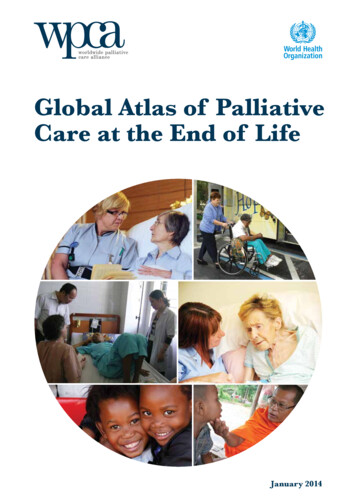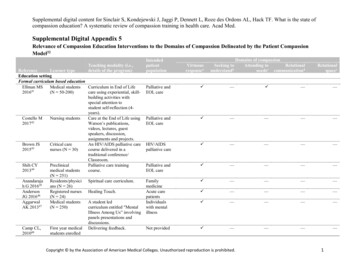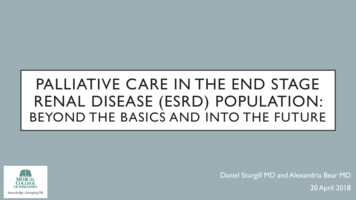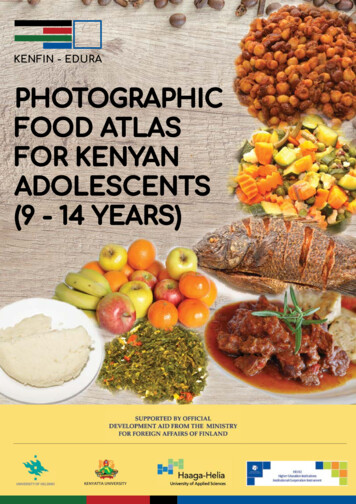
Transcription
Global Atlas of PalliativeCare at the End of LifeJanuary 2014
Acknowledgements and authorshipEdited by:Stephen R. Connor, PhD, Senior Fellow to the Worldwide Palliative Care Alliance (WPCA).Maria Cecilia Sepulveda Bermedo, MD, Senior Adviser Cancer Control, Chronic DiseasesPrevention and Management, Chronic Diseases and Health Promotion, World Health Organization.The views expressed in this publication do not necessarily represent the decisions, policy or viewsof the World Health Organization.This publication was supported in part by a grant from the Open Society Foundations’ InternationalPalliative Care Initiative. Special thanks to Mary Callaway and Dr Kathleen Foley.Contributing writers:Sharon Baxter, MSW, Canadian Hospice Palliative Care Association, CanadaSamira K. Beckwith, ACSW, LCSW, FACHE, Hope Hospice, Ft Myers, FL, USADavid Clark, PhD – University of Glasgow, ScotlandJames Cleary, MD – Pain and Policies Study Group, Madison, WI, USADennis Falzon, MD – WHO Global TB Program, WHO GenevaPhilippe Glaziou, MD, MPhil, Dip Stat – WHO Global TB Program, WHO GenevaPeter Holliday, St. Giles Hospice, Litchfield, EnglandErnesto Jaramillo, MD – WHO Global TB Program, WHO GenevaEric L. Krakauer, MD, PhD – Harvard Medical School Center for Palliative Care, Boston, MA, USASuresh Kumar, MD – Neighborhood Network in Palliative Care, Kerala, IndiaDiederik Lohman – Human Rights Watch, New York, USAThomas Lynch, PhD – International Observatory for End of Life Care, Lancaster, EnglandPaul Z. Mmbando (MBChB, MPH, DrH) Evangelical Lutheran Church, Arusha, TanzaniaClaire Morris, Worldwide Palliative Care Alliance, London, EnglandDaniela Mosoiu, MD – Hospice Casa Sperantei, Brasov, RomaniaFliss Murtagh FRCP PhD MRCGP, Cicely Saunders Institute, Kings College LondonRoberto Wenk, MD – Programa Argentino de Medicina Paliativa Fundación, ArgentinaIn addition, the editors would like to thank the following:All WHO collaborating centres on palliative care (see appendix for details)Ricardo X. Martinez, PhD, statistics and mapping consultantLaura van Buul, WHO Intern; Lutien Bakker, WHO InternJulie Torode, Union for International Cancer Control, GenevaEAPC Atlas of Palliative Care in Europe Task Force.COPYRIGHT 2014 by Worldwide Palliative Care Alliance, All Rights Reserved.The World Health Organization has granted Worldwide Palliative Care Alliance permission for the reproductionof Chapter 2, entitled How many people at the end of life are in need of palliative care worldwide? WHO retainscopyright of Chapter 2 and grants permission for use in this publication. World Health Organization 2014ISBN: 978-0-9928277-0-0
Worldwide Palliative Care AllianceThe Worldwide Palliative Care Alliance (WPCA) is a global action network focusing exclusively onhospice and palliative care development worldwide. Its members are national and regional hospiceand palliative care organisations and affiliate organisations supporting hospice and palliative care.WPCA BoardDavid Praill, co-Chair, Help the Hospices, the United KingdomCynthia Goh, MD, co-Chair, Asia Pacific Hospice Palliative Care Network, SingaporeZipporah Ali MD, Kenya Hospices and Palliative Care AssociationSharon Baxter, Canadian Hospice Palliative Care Association, CanadaJorge Eisenschlas, MD, Asociación Latinoamericana de Cuidados Paliativos, ArgentinaLiz Gwyther, MD, Hospice Palliative Care Association of South AfricaEdnin Hamzah, MD, Hospis MalaysiaYvonne Luxford, PhD, Palliative Care AustraliaEmmanuel Luyirika MD, African Palliative Care Association, UgandaJoan Marston, RN, International Children’s Palliative Care Network, South AfricaAnil Paleri, MD, Indian Association of Palliative CareSheila Payne, PhD, European Association of Palliative Care, the United KingdomDon Schumacher, PsyD, National Hospice and Palliative Care Organization, USAWorldwide Hospice Palliative Care AllianceCompany Limited by Guarantee, Registered in England and Wales No 6735120, Registered Charity No 1127569,Registered Office: Hospice House, 34-44 Britannia Street, London WC1X 9JGehospiceehospice is the first globally managed news and information website and app on hospice, palliativeand end of life care, bringing you the latest news, intelligence, commentary and analysis from thesector. At the touch of a button, you can access the expertise and experience of the global palliativecare community.Aimed at anyone with a professional or personal interest in palliative care, ehospice gives access tonews, current research findings, coverage of major meetings and conferences, policy developments,updates from organisations within the palliative care field, job and event listings and a globaldirectory of service providers. There are also inspirational elements, with rich photo galleries,personal stories and a ‘be inspired’ feature.There are several country/region editions and separate international editions for adult andchildren’s care.www.ehospice.comWWW.WHO.INTWWW.THEWPCA.ORGi
Table of contentsAcronyms. 1Forewords. 2Chapter 1Introduction. 4What is palliative care for adults, for children?. 5The definition of palliative care. 7The relationship between curative and palliative care. 8Why is palliative care a human rights issue?. 9Chapter 2How many people at the end of life are in need ofpalliative care worldwide?. 10Diseases requiring palliative care. 10Estimates based on the number of patients dying from cancer andother life-limiting conditions and the estimated number of familyand healthcare givers. 11Maps depicting the overall palliative care needs by age( 15 and 15 years of age) and gender. 13Maps and tables describing the need for palliative care at theend of life for adults. 14Maps and tables describing the need for palliative care at theend of life for children. 19Summary and conclusions.25Chapter 3What are the main barriers to palliativecare development?.27Based on policy, education, and opioid availability.27Maps on opioid use by country.29Psychological, social, cultural, and financial barriers. 31Palliative care for TB: a new and emerging issue. 31Chapter 4What is the response to address the needs and barriersto good quality palliative care?.34Maps showing levels of palliative care development by country.35Map showing the availability of children’s palliative care services.43Maps showing numbers of palliative care-specific providers tobase population. 46iiWWW.WHO.INTWWW.THEWPCA.ORG
Chapter 5What are existing models of palliative care(including financial mechanisms) in differentresource settings?Case studies of different models of care. 47Kerala, India. 48Arusha, Tanzania.50Brasov, Romania. 52Ft. Myers, Florida, USA.54Ho Chi Minh City, Vietnam.56Buenos Aires, Argentina.58Lichfield, England. 60Chapter 6What are the available resources at global/regionallevels to support palliative care policies, programmesand research in low-middle income countries?.62Financial resources devoted to palliative care.62Philanthropic and bilateral support.63Research support. 64Educational resources.65Chapter 7What is the way forward to advance palliative care inthe health and human rights agendas at global/regional/country levels? And conclusions. 71Appendix 1Methodology for a Global Atlas of Palliative Care at theEnd of Life. 76Appendix 2Additional sections of the Mapping levels ofPalliative Care Report. 78Appendix 3Organisational resources. 84Appendix 4WHO collaborating centres on palliative care. 90Appendix 5Report on cost-effectiveness of palliative care. 91Appendix 6Methodology for estimating the need for palliative care,including a country-by-country ii
List of figures1. Distribution of major causes of death worldwide (2011). 112. Distribution of people in need of palliative care at theend of life by age group. 123. World map showing the global distribution by regions of ratesfor people in need of palliative care at the end of life. 134. Distribution of adults in need of palliative care at theend of life by gender. 135. Distribution of adults in need of palliative care at theend of life by disease groups. 146. Distribution of adults in need of palliative care at theend of life by age and disease groups. 147. Distribution of adults in need of palliative care at theend of life by WHO regions. 158. Rates of adults in need of palliative care at the end of lifeby WHO region. 159. Distribution of adults in need of palliative care at theend of life by WHO regions and disease categories. 1610. Distribution of adults in need of palliative care at theend of life by World Bank country income groups. 1611. Rates of adults in need of palliative care at the end of lifeby World Bank country income groups. 1712. World map showing the global distribution by WHO regionsof rates for adults in need of palliative care at the end of life. 1713. World map showing the global distribution by regions of ratesfor adults in need of palliative care for cancer at the end of life. 1814. World map showing the global distribution by WHO regions ofrates for adults in need of palliative care for HIV/AIDS at theend of life. 1815. World map showing the global distribution by WHO regionsof rates for adults in need of palliative care for progressivenon-malignant disease at the end of life. 1916. Distribution of children in need of palliative care at theend of life by gender. 1917. Distribution of children in need of palliative care at theend of life by disease groups.2018. Distribution of children in need of palliative care at theend of life by WHO regions.20ivWWW.WHO.INTWWW.THEWPCA.ORG
19. Rates of children in need of palliative care at the end of lifeby WHO regions. 2120. Distribution of children in need of palliative care at theend of life by WHO regions and disease categories. 2121. Distribution of children in need of palliative care at theend of life World Bank country income groups.2222. Rates of children in need of palliative care at the end of lifeby World Bank country income groups.2223. World map showing the global distribution by regions of ratesfor children in need of palliative care at the end of life.2324. World map showing the global distribution by WHO regionsof rates for children in need of palliative care for cancer at theend of life.2325. World map showing the global distribution by WHO regions ofrates for children in need of palliative care for HIV/AIDS at theend of life. 2426. World map showing the global distribution by regions of ratesfor children in need of palliative care for progressivenon-malignant diseases at the end of life. 2427. Morphine use worldwide.2928. Morphine equivalent total opioid use worldwide.2929. Public health model for palliative care development.3030. World map showing the global mortality rates for tuberculosisincluding HIV-positive for all ages.3231. Countries with no known hospice/palliative care activity(Level 1).3532. Countries with capacity building activity (Level 2).3633. Countries with isolated provision of palliative care (Level 3a).3834. Countries with generalised provision of palliative care (Level 3b).3835. Countries with preliminary health system integration (Level 4a). 4036. Countries with advanced health system integration (Level 4b). 4037. Levels of palliative care development – all countries.4238. Levels of paediatric palliative care development – all countries.4339. Services/providers to base population (per 1M population). 4640. Estimated number of patients receiving palliative care. 46WWW.WHO.INTWWW.THEWPCA.ORGv
AcronymsThis list is confined to acronyms used more than once, and in more thanone place, within the main chapters of this book.AFROAfrican Region of the World Health OrganizationAMRORegional Office for the Americas of the WorldHealth OrganizationCESCRCommittee on Economic, Social and Cultural RightsEMROEastern Mediterranean Region of the World HealthOrganizationEUROEuropean Region of the World Health OrganizationICESCRInternational Covenant on Economic, Social andCultural RightsINCBInternational Narcotics Control BoardINESCR UN Committee on Economic, Social, and Cultural RightsIOELCInternational Observatory on End-of-Life CareNHPCONational Hospice and Palliative Care OrganizationSEAROSoutheast Asian Region of the World Health OrganizationUNUnited NationsUNICEF United Nations Children’s FundWWW.WHO.INTWHOWorld Health OrganizationWPCAWorldwide Palliative Care AllianceWPROWestern Pacific Region of the World Health OrganizationWWW.THEWPCA.ORG1
ForewordPalliative care, while still a relatively new component to modernhealthcare, is increasingly recognised as an essential part of all healthcaresystems. Despite this, it is widely acknowledged that there is stillinadequate access to hospice and palliative care worldwide, and withan ageing population who are going to be living and dying with morecomplex conditions, the demand for care is only going to increase.Now, for the first time, we have a resource that attempts to quantifythe need for and availability of palliative care worldwide.It is important to acknowledge that, while the atlas focuses on the needof patients at the end of life, many more people early in their courseof illness, as well as family members and carers, could also benefitfrom palliative care, and therefore the real need is much greater.Historically, hospice and palliative care programmes have focused onthe needs of cancer patients known to have high symptom burdens.However, the majority of those needing palliative care worldwidesuffer from non-malignant conditions, which are defined in this atlas.We hope we can encourage countries to ensure that efforts to expandpalliative care include these patients with other life-threatening illnesseswho also suffer during their treatment, illness, and end of life.WHO has focused in recent years on HIV/AIDS, tuberculosis andother infectious diseases and now has a major initiative to address theburdens of non-communicable disease. Palliative care is needed forthese conditions, but what is also needed is for the global communityto work together to help prevent early mortality from communicableand non-communicable diseases. Palliative care, while vital atthe end of life, also has a key role to play in this prevention.Our efforts to expand palliative care need to focus on bringingrelief of suffering and the benefits of palliative care to thosewith the least resources. This will take courage and creativityas we learn from each other how to integrate palliative careinto existing but very limited healthcare systems.This global atlas shines a light on the need for palliative careglobally, and serves as a baseline, against which to makemeasurements, in order to advocate for increased access.Cynthia Goh, MD Co-Chair WPCADavid Praill, Co-Chair WPCA2WWW.WHO.INTWWW.THEWPCA.ORG
ForewordThe WHO, together with its partners, is working on the implementationof the Global Action Plan for the Prevention and Control ofNoncommunicable Diseases 2013-2020. While we join efforts to reducethe burden of the biggest killers in the world today, we must also alleviatethe suffering of those with progressive illnesses so their quality of lifeis improved. This joint WHO-WPCA publication is an outstandingexample of collaborative effort to position palliative care higher in theglobal and national health agendas. The great majority of palliative careneed is associated with noncommunicable diseases.The Global Atlas of Palliative Care at the End of Life is an excellent toolto advocate for the inclusion of palliative in the global, regional andnational health agendas. In its Chapter 2, WHO provides for the firsttime quantitative estimates on the need of palliative care for adults andchildren. Each year around 20 million people need end of life palliativecare, including 6% that are children. These are low level estimatesbecause around 20 million more require palliative care in the yearsbefore death. The numbers are huge and so is the unmet need as onlya few countries have implemented equitable palliative care programsthrough a public health approach. Moreover, in many countries opioidanalgesics are not available or accessible to the majority of patientssuffering moderate or severe pain.In January 2014 the WHO Executive Board will address the need fortaking global and national action for the integration of palliative care intohealth systems. A group of Member States is supporting this initiative andthe WHO secretariat has developed a comprehensive report that includesthe global estimates. Thus the publication of the Global Atlas comes ata very timely moment. It not only provides evidence on the needs acrossvarious disease groups and conditions in adults and children, but alsoanalyses models that work in different resource settings and stimulatesurgent action. We are certain that this comprehensive information will bevery useful for the executive board members when taking a decision onhow to move this agenda forward.WHO will continue collaborating with WPCA and other partners tosupport countries in their efforts to develop palliative care policies andservices and to ensure that the majority of the patients get the care theyneed even in limited resource settings.Dr Oleg ChestnovAssistant Director GeneralNoncommunicable Diseases and Mental HealthWWW.WHO.INTWWW.THEWPCA.ORG3
Chapter 1 IntroductionThe need for palliative care has never been greater and is increasing at arapid pace due to the world’s ageing population and increases in cancerand other noncommunicable diseases. Despite this need, palliative careis underdeveloped in most of the world, and outside North America,Europe, and Australia, access to quality palliative care is very rare.Palliative care is expanding in the developed world in spite of myths andmisunderstanding about its nature and purpose, but is only beginning tobe available in the developing world where it is needed most.Since the early 1980s, the need for palliative care for cancer patientshas been progressively acknowledged worldwide. More recently, thereis increased awareness of the need for palliative care for other chronicdiseases or conditions such as HIV/AIDS, congestive heart failure,cerebrovascular disease, neurodegenerative disorders, chronic respiratorydiseases, drug-resistant tuberculosis, and diseases of older people.However, there remains a huge unmet need for palliative care for thesechronic life-limiting health problems in most parts of the world.The purpose of this Atlas is to shine a light on the need for palliative careglobally and to provide useful information for those wishing to increaseaccess. This document addresses the following questions:4nWhat is palliative care?nWhy is palliative care a human rights issue?nWhat are the main diseases requiring palliative care?nWhat is the need for palliative care?nWhat are the barriers to palliative care?nWhere is palliative care currently available?nWhat are the models of palliative care worldwide?nWhat resources are devoted to palliative care?nWhat is the way forward?WWW.WHO.INTWWW.THEWPCA.ORG
Chapter 1IntroductionWhat is palliative care for adults, for children?WHO definition of palliative careIn 2002, the World Health Organization established a revised definitionof palliative care for adults and a separate one for children:Palliative care is an approach that improves the quality of life of patientsand their families facing the problem associated with life-threateningillness, through the prevention and relief of suffering by means of earlyidentification and impeccable assessment and treatment of pain and otherproblems, physical, psychosocial and spiritual. Palliative care:WWW.WHO.INTnprovides relief from pain and other distressing symptoms;naffirms life and regards dying as a normal process;nintends neither to hasten or postpone death;nintegrates the psychological and spiritual aspects of patient care;noffers a support system to help patient’s live as actively as possibleuntil death;noffers a support system to help the family cope during the patientsillness and in their own bereavement;nuses a team approach to address the needs of patients and theirfamilies, including bereavement counselling, if indicated;nwill enhance quality of life, and may also positively influence thecourse of illness;nis applicable early in the course of illness, in conjunction with othertherapies that are intended to prolong life, such as chemotherapy orradiation therapy, and includes those investigations needed to betterunderstand and manage distressing clinical complications.WWW.THEWPCA.ORG5
Chapter 1IntroductionWHO definition of palliative care for childrenPalliative care for children represents a special, albeit closely related fieldto adult palliative care. WHO’s definition of palliative care appropriatefor children and their families is as follows; the principles apply to otherpaediatric chronic disorders.1Palliative care for children is the active total care of the child’s body,mind and spirit, and also involves giving support to the family.nIt begins when illness is diagnosed, and continues regardless ofwhether or not a child receives treatment directed at the disease.nHealth providers must evaluate and alleviate a child’s physical,psychological, and social distress.nEffective palliative care requires a broad multidisciplinary approachthat includes the family and makes use of available communityresources; it can be successfully implemented even if resourcesare limited.nIt can be provided in tertiary care facilities, in community healthcentres and even in children’s homes.Definition of Hospice2 – Hospice care is end-of-life care providedby health professionals and volunteers. They give medical, psychologicaland spiritual support. The goal of the care is to help people who aredying have peace, comfort and dignity. The caregivers try to controlpain and other symptoms so a person can remain as alert andcomfortable as possible. Hospice programmes also provide servicesto support a patient’s family.6WWW.WHO.INTWWW.THEWPCA.ORG
Chapter 1IntroductionThe definition of palliative careThe Global Atlas adopts the current World Health Organizationdefinition of palliative care. However, it has been recognised for someyears that this definition requires further explanation to clarify thecomprehensive nature of palliative care (WPCA Policy statementon defining palliative care)3. We elucidate this here, with supportingevidence, to ensure the definition is more explicit and transparent.First, palliative care is needed in chronic as well as lifethreatening/limiting-conditions.nAdults with a wide range of chronic conditions throughout theworld have been recognised as benefiting from palliative care4,5,6,7,8.Early intervention, well before the terminal stage, is recognised asoptimal9,10.nThe WHO definition of palliative care for children states thatpalliative care should be provided to children with chronic and lifelimiting illness, not only those who are dying. Paediatric palliativecare begins when the illness is diagnosed, and continues regardless ofwhether or not a child receives treatment directed at the disease.Second, there is no time or prognostic limit on the delivery ofpalliative care.nIt has been widely advocated that palliative care should be deliveredon the basis of need, not diagnosis or prognosis11,12,13,14.nAlthough we have estimated numbers based on mortality data forconsistency, palliative care should be provided ‘early in the course ofthe illness’ (WHO definition of palliative care) and at least as manypeople are estimated to have palliative care needs before the last yearof life as during the last year of life.Third, the Global Atlas describes the need for palliative care at alllevels of care.WWW.WHO.INTnPalliative care is not limited to specialist palliative care services butincludes primary and secondary level care.nPalliative care is provided at three different levels: i) through a‘palliative care approach’ adopted by all healthcare professionals,provided they are educated and skilled through appropriate trainingii) ‘general palliative care’ provided by primary care professionalsand those treating patients with life-threatening diseases, with a goodbasic knowledge of palliative care, and iii) ‘specialist palliative care’provided by specialised teams for patients with complex problems15,16.WWW.THEWPCA.ORG7
Chapter 1IntroductionnThe Global Atlas includes all three levels, and the requirementfor provision at the three different levels will vary from country tocountry, depending on the proportion of deaths from palliative carediagnoses, according to models of healthcare, and the nature andextent of integration of palliative care within these models. In highincome countries, it is estimated that between 30-45% of palliativecare need may be met by specialist palliativ
Global Atlas of Palliative Care at the End of Life January 2014. Acknowledgements and authorship Edited by: Stephen R. Connor, PhD, Senior Fellow to the Worldwide Palliative










